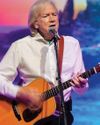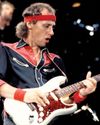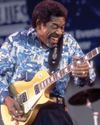
Chicago is synonymous with legendary blues names such as Muddy Waters and Howlin’ Wolf. These, and many more would make a name for themselves in the clubs and juke joints of the South and West sides of the city after migrating from southern states like Mississippi in the 1940s, 50s and 60s. At a time when electrifying guitars was new, drums and amplification were being used in the clubs to create a sound that was louder, and a far cry from the acoustic sound of the South. Pioneers like Waters, Elmore James, Little Walter and Jimmy Rogers would go on to influence many aspiring musicians who themselves would sign with Chicago record labels like Chess, Cobra, Chief and Delmark. Later, world famous names like The Rolling Stones and Eric Clapton would be influenced by these other artists, so their affect on the world of music has been far reaching indeed.
We’re going to look at 10 pioneering Chicago blues guitarists. Some may be more ‘household names’ than others, but each had his own approach and sound, and all used the notes that are the bedrock of the blues - root, b3rd, 4th 5th and b7th, or Minor Pentatonic scale. With the often added Major 2nd, 3rd and 6th from the Major Pentatonic and using approaches like ‘curling’ the b3rd, string bends and slides, an almost inexhaustible vocabulary was created and used by all of them.
I have written and recorded 10 separate 12-bar blues in the style of these players, in a variety of keys, tempos and technical difficulty. I strongly suggest that, as well as going through these, you also investigate recorded material from these great players.
ELMORE JAMES
この記事は Guitar Techniques の February 2022 版に掲載されています。
7 日間の Magzter GOLD 無料トライアルを開始して、何千もの厳選されたプレミアム ストーリー、9,000 以上の雑誌や新聞にアクセスしてください。
すでに購読者です ? サインイン
この記事は Guitar Techniques の February 2022 版に掲載されています。
7 日間の Magzter GOLD 無料トライアルを開始して、何千もの厳選されたプレミアム ストーリー、9,000 以上の雑誌や新聞にアクセスしてください。
すでに購読者です? サインイン

THE MOODY BLUES
This month Stuart Ryan delves into the picking style of this British prog legend whose acoustic guitar has powered many a Moody Blues song.

WAYNE KRANTZ
This issue Nick Mellor provides an insight into this brilliant jazz stylist, focusing on his approach to improvising over static chords.

OPEN G TUNING
Open tunings are great fun and can help create exciting new ideas. Simon Barnard shows how to incorporate open G tuning into your playing.

RODRIGO GOUVEIA
Last month we featured Mateus Asato, and mentioned the importance of the neo-soul style in his playing. Here we turn to his fellow Brazilian, the master of neo-soul fusion.

MARK KNOPFLER
Our topic this month is a master craftsman as both guitar player and songwriter. His style is unique and his influence spreads far and wide.

U2
Martin Cooper checks out the chiming pedal delay tones of this stadium-filling band from Dublin, Ireland, and guitarist The Edge.

LUTHER ALLISON
It’s blues with a touch of soul this month, as David Gerrish explores the dynamic, expressive style of an often overlooked Chicago bluesman.

JOHANN KASPAR MERTZ Capriccio
This month Declan Zapala explores the music of Austria at the turn of the Romantic period with a fiery caprice to level up your fingers and unlock your inner virtuoso.

THE CROSSROADS Michael Landau
John Wheatcroft explores the playing of a session ace _ and blazing blues-rock maestro who graces the top-flight m band of singer-songwriting legend, James Taylor.

VIDEO MASTERCLASS Troy Redfern
This month GT welcomes this slide guitar virtuoso. If you've been wanting to take your slide playing to the next level then this is one's for you. With Jon Bishop.